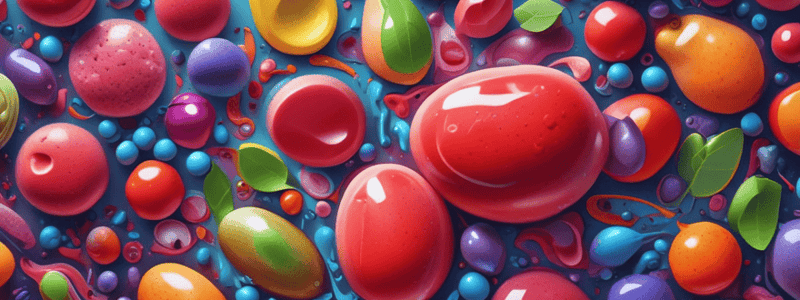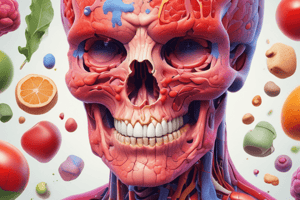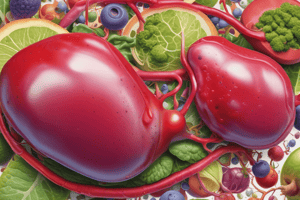Podcast
Questions and Answers
Where do cell nutrients circulating in the blood primarily come from?
Where do cell nutrients circulating in the blood primarily come from?
- Atmospheric sources
- Diet (correct)
- Genetic inheritance
- Intravenous injections
Which of the following is NOT mentioned as a source of cell nutrients in the text?
Which of the following is NOT mentioned as a source of cell nutrients in the text?
- Release from storage in body tissues
- Diet
- Replenishment from the brain (correct)
- Synthesis in body tissues
What are some of the physiological situations that can cause changes in the blood concentration of cell nutrients?
What are some of the physiological situations that can cause changes in the blood concentration of cell nutrients?
- Malnutrition and enzyme deficiency states
- Fasting and exercise (correct)
- Atherosclerosis and shock
- Diabetes and obesity
Which tissues are involved in the metabolism of cell nutrients including degradation for energy release?
Which tissues are involved in the metabolism of cell nutrients including degradation for energy release?
In addition to liver, which other body tissue is mentioned as being involved in the storage of cell nutrients?
In addition to liver, which other body tissue is mentioned as being involved in the storage of cell nutrients?
What are some of the pathological conditions that can lead to changes in the blood concentration of cell nutrients?
What are some of the pathological conditions that can lead to changes in the blood concentration of cell nutrients?
What is the main role of ATP and ADP in the cell?
What is the main role of ATP and ADP in the cell?
What is the difference between ATP and ADP?
What is the difference between ATP and ADP?
Which molecule acts as a small store of free energy in muscle cells?
Which molecule acts as a small store of free energy in muscle cells?
When are catabolic pathways activated?
When are catabolic pathways activated?
Which compound is important in producing ATP from ADP in glycolysis via substrate-level phosphorylation?
Which compound is important in producing ATP from ADP in glycolysis via substrate-level phosphorylation?
What is the function of creatinine in the body?
What is the function of creatinine in the body?
What signals the activation of anabolic pathways?
What signals the activation of anabolic pathways?
'High-energy signals' such as NADH, NADPH, and FAD2H indicate what in the cell?
'High-energy signals' such as NADH, NADPH, and FAD2H indicate what in the cell?
Which of the following statements regarding cell metabolism is correct?
Which of the following statements regarding cell metabolism is correct?
Which of the following statements is true regarding biological oxidation?
Which of the following statements is true regarding biological oxidation?
What is the function of carrier molecules like NAD+, NADP+, and FAD in cell metabolism?
What is the function of carrier molecules like NAD+, NADP+, and FAD in cell metabolism?
What is the relationship between enthalpy change (H) and free energy change (G) in a chemical reaction?
What is the relationship between enthalpy change (H) and free energy change (G) in a chemical reaction?
What is the significance of the standard free energy change (G) in cell metabolism?
What is the significance of the standard free energy change (G) in cell metabolism?
Which of the following statements about exergonic and endergonic reactions is correct?
Which of the following statements about exergonic and endergonic reactions is correct?
Which of the following statements regarding the functions of cell metabolism is correct?
Which of the following statements regarding the functions of cell metabolism is correct?
Which of the following statements about the total concentration of carrier molecules (e.g., NAD+/NADH, NADP+/NADPH) in cells is correct?
Which of the following statements about the total concentration of carrier molecules (e.g., NAD+/NADH, NADP+/NADPH) in cells is correct?
Which of the following statements about the components of carrier molecules like NAD+ and FAD is correct?
Which of the following statements about the components of carrier molecules like NAD+ and FAD is correct?
Flashcards are hidden until you start studying




